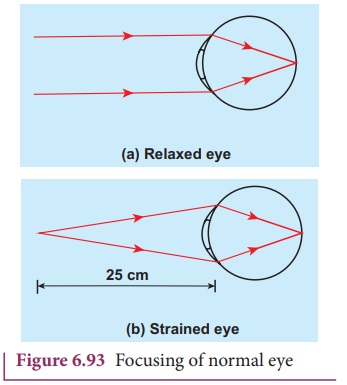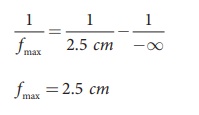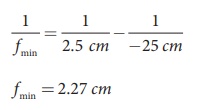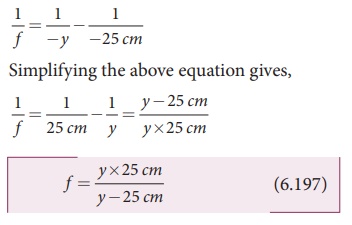Optical Instruments - The eye | 12th Physics : UNIT 7 : Wave Optics
Chapter: 12th Physics : UNIT 7 : Wave Optics
The eye
The eye
Eye is a natural optical instrument
given by God to the human beings. The internal structure and the Physics aspect
of the functioning of different parts of human eye are discussed already in (X
Physics Unit-2). As the eye lens is flexible, its focal length can be changed
to some extent. When the eye is fully relaxed, the focal length is maximum and
when it is strained the focal length is minimum. The image must be formed on
the retina for a clear vision. The diameter of eye for a normal adult is about
2.5 cm. Hence, the image-distance, in other words, the distance between eye
lens and retina is fixed always at 2.5 cm for a normal eye. We can just discuss
the optical functioning of eye without giving importance to the refractive
indices of the two liquids, aqueous humor and virtuous humor present in the eye
A person with normal vision can see objects kept at infinity in the relaxed
condition with maximum focal length fmax
of the eye as shown in Figure 6.93(a). Also at a distance of 25 cm in the
strained condition with minimum focal
length fmin of the eye as shown
in Figure 6.93(b).

Let us find fmax and fmin
of human eye from the lens equation given below.

When the object is at infinity, u = ŌĆōŌł×, and v = 2.5 cm (distance between eye lens and retina), the eye can see
the object in relaxed condition with fmax.
Substituting these values in the lens equation gives,

When the object is at near point, u = ŌĆō25 cm, and v = 2.5 cm, the eye can
see the object in strained condition with fmin.
Substituting these values in the lens equation gives,

See, the small variation of fmax ŌłÆ fmin = 0.23 cm of
the focal length of eye lens makes objects visible from infinity to near point
for a normal person. Now, we can discuss some common defects of vision in the
eye.
Nearsightedness (myopia)
A person suffering from
nearsightedness or myopia cannot see
distant objects clearly. This may result because the lens has too short focal length
due to thickening of the lens or larger diameter of the eyeball than usual.
These people have difficulty in relaxing their eye more than what is needed to
overcome this difficulty. Thus, they need correcting lens.
The parallel rays coming from the distant
object get focused before reaching the retina as shown in Figure 6.94(a). But,
these persons can see objects which are nearer. Let x be the maximum distance up to which a person with nearsightedness
can see as shown in Figure 6.94(b). To overcome this difficulty, the virtual
image of the object at infinity should be formed at a distance x from the eye using a correcting lens
as shown in Figure 6.93(c).
The focal length of the correcting
lens for a myopic eye can be calculated using the lens equation.

Here, u = ŌĆōŌł×, v = ŌĆōx. Substituting thes values in the lens
equation gives,

Focal length f of the correcting
lens is,
f = ŌĆōx (6.196)

The negative sign in the above
result suggests that the lens should be a concave lens. Basically, the concave
lens slightly diverges the parallel rays from infinity and makes them focus now
at the retina which got earlier focused before reaching retina in the unaided
condition.

Farsightedness (hypermetropia)
A person suffering from
farsightedness or hypermetropia or hyperopia cannot clearly see objects
close to the eye. It occurs when the eye lens has too long focal length due to
thining of eye lens or shortening of the eyeball than normal. The least distance
for clear vision for these people is appreciably more than 25 cm and the person
has to keep the object inconveniently away from the eye. Thus, reading or
viewing smaller things held in the hands is
difficult for them. This kind of farsightedness
arising due to aging is called presbyopia
as the aged people cannot strain their eye more to reduce the focal length
of the eye lens.

The rays coming from the object at
near point get focused beyond the retina as shown in Figure 6.95(a). But, these
persons can see objects which are far say, more than 25 cm. Let y be the minimum distance from the eye
beyond which a person with farsightedness can see as shown in Figure 6.95(b).
To overcome this difficulty, the virtual image of the object at y should be
formed at a distance of 25 cm (near point) from the eye using a correcting lens
as shown in Figure 6.95(c).
The focal length of the correcting
lens for a hypermetropic eye can be calculated using the lens equation.

Here, u = ŌĆōy, v = ŌĆō25 cm. Substituting these values in
the lens equation gives,

The focal length calculated using
above formula will be positive as y is
always greater than 25 cm. The positive sign of the focal length suggests that
the lens should be a convex lens. In principle, the convex lens slightly
converges the rays coming from beyond y and
makes them focus now at the retina which got earlier focused beyond retina for
the unaided eye.
Astigmatism
Astigmatism is the defect arising
due to different curvatures along different planes in the eye lens. Astigmatic person cannot see all the directions equally
well. The defect due to astigmatism is more serious than myopia and hyperopia.
The remedy to astigmatism is using of lenses with different curvatures in
different planes to rectify the defect. In general, these specially made
glasses with different curvature for different planes are called as cylindrical
lenses.
Due to aging people may develop
combination of more than one defect. If it is the combination of
nearsightedness and farsightedness then, such persons may need a converging
glass for reading purpose and a diverging glass for seeing at a distance.
Bifocal lenses and progressive lenses provide solution for these problems.
EXAMPLE 6.44
Calculate the power of the lens of
the spectacles necessary to rectify the defect of nearsightedness for a person
who could see clearly only up to a distance of 1.8 m.
Solution
The maximum distance the person
could see is, x = 1.8 m.
The lens should have a focal length
of,
f = ŌĆōx m = ŌĆō1.8
m.
It is a concave or diverging lens.
The power of the lens is,
P = ŌłÆ 1/1.8 m
= ŌłÆ0.56 diopter
EXAMPLE 6.45
A person has farsightedness with the
minimum distance he could see clearly is 75 cm. Calculate the power of the lens
of the spectacles necessary to rectify the defect.
Solution
The minimum distance the person
could see clearly is, y = 75 cm.
The lens should have a focal length
of,

f = y├Ś25 cm / y-25 cm
f = [75 cm├Ś25 cm ] / [75 cm ŌłÆ25 cm] = 37.5 cm
It is a convex or converging lens.
The power of the lens is,
P = 1 / 0.375 m = 2.67 diopter
Related Topics